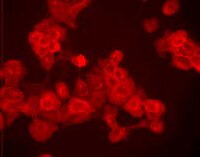GR15 Sigma-AldrichAnti-EGFR (Ab-5) Mouse mAb (EGFR.1)
Anti-EGFR (Ab-5), mouse monoclonal, clone EGFR.1, recognizes the ~170 kDa EGF receptor protein in A431 cells. It is validated for use in FC, IF, and IP.
More>> Anti-EGFR (Ab-5), mouse monoclonal, clone EGFR.1, recognizes the ~170 kDa EGF receptor protein in A431 cells. It is validated for use in FC, IF, and IP. Less<<Synonyms: Anti-Epidermal Growth Factor Receptor
Recommended Products
Overview
| Replacement Information |
|---|
Key Spec Table
| Species Reactivity | Host | Antibody Type |
|---|---|---|
| H | M | Monoclonal Antibody |
Products
| Catalogue Number | Packaging | Qty/Pack | |
|---|---|---|---|
| GR15-100UGCN | Plastic ampoule | 100 μg |
| References | |
|---|---|
| References | Hunter T., 1984. Nature 311, 414. Reynolds, F.H., Jr., et al. 1981. Nature 292, 259. Ushiro, H. and Cohen, S. 1980. J. Biol. Chem. 255, 8363. |
| Product Information | |
|---|---|
| Form | Liquid |
| Formulation | In 50 mM sodium phosphate, 0.2% gelatin, pH 7.5. |
| Negative control | HL-60 cells |
| Positive control | A-431 cells |
| Preservative | ≤0.1% sodium azide |
| Quality Level | MQ100 |
| Physicochemical Information |
|---|
| Dimensions |
|---|
| Materials Information |
|---|
| Toxicological Information |
|---|
| Safety Information according to GHS |
|---|
| Safety Information |
|---|
| Product Usage Statements |
|---|
| Storage and Shipping Information | |
|---|---|
| Ship Code | Blue Ice Only |
| Toxicity | Standard Handling |
| Storage | +2°C to +8°C |
| Do not freeze | Yes |
| Packaging Information |
|---|
| Transport Information |
|---|
| Supplemental Information |
|---|
| Specifications |
|---|
| Global Trade Item Number | |
|---|---|
| Catalogue Number | GTIN |
| GR15-100UGCN | 04055977228267 |
Documentation
Anti-EGFR (Ab-5) Mouse mAb (EGFR.1) SDS
| Title |
|---|
Anti-EGFR (Ab-5) Mouse mAb (EGFR.1) Certificates of Analysis
| Title | Lot Number |
|---|---|
| GR15 |
References
| Reference overview |
|---|
| Hunter T., 1984. Nature 311, 414. Reynolds, F.H., Jr., et al. 1981. Nature 292, 259. Ushiro, H. and Cohen, S. 1980. J. Biol. Chem. 255, 8363. |








